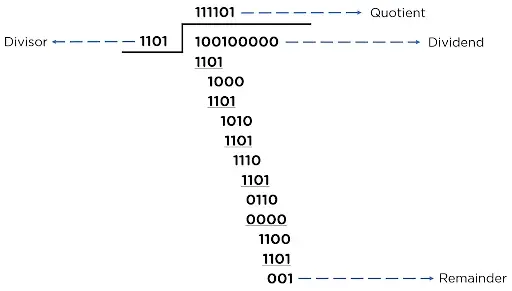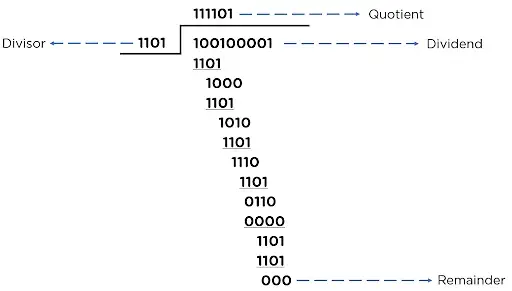Sender Side (CRC Generator and Modulo Division):
- The first step is to add the number of
0to the data to be sent, calculated usingk-1(kis the bits obtained through the polynomial equation.) - Applying the Modulo Binary Division to the data bit by applying the XOR and obtaining the remainder from the division
- The last step is to append the remainder to the end of the data bit and share it with the receiver.
- Example - The data bit to be sent is
[100100], and the polynomial equation is[x3+x2+1]. - Data bit - 100100
- Divisor (k) - 1101 (Using the given polynomial)
- Appending Zeros - (k-1) > (4-1) > 3
- Dividend - 100100000

Modulo binary division is a method of binary division that uses the modulo operation to find the remainder of a division. In this method, instead of subtracting the divisor from the dividend, we use the XOR operation to find the remainder.
Receiver Side (Checking for Errors in the Received data):
To check the error, perform the Modulo division again and check whether the remainder is 0 or not,
- If the remainder is 0, the data bit received is correct, without any errors.
- If the remainder is not 0, the data received is corrupted during transmission.

CRC32
-
CRC33?
- Technically, the CRC 32-bit constant
0x04C11DB7is really a 33-bit constant0x104C11DB7which is classified as an IEEE-802 CRC. See RFC 3385
- Technically, the CRC 32-bit constant
-
When we XOR the data byte into the current CRC value do we start at the top or bottom bits?
-
Which direction do we shift the CRC bits?
-
How do we convert this formula into a table where we handle all 8-bits at once?
-
Reflected= Shift Right -
The data bytes are fed into the bottom 8 bits of the CRC value
-
We test the bottom-bit of the CRC value
-
We invert the final CRC value
uint32_t crc32_formula_reflect( size_t len, const void *data, const uint32_t POLY = 0xEDB88320 )
{
const unsigned char *buffer = (const unsigned char*) data;
uint32_t crc = -1;
while( len-- )
{
crc = crc ^ *buffer++;
for( int bit = 0; bit < 8; bit++ )
{
if( crc & 1 ) crc = (crc >> 1) ^ POLY;
else crc = (crc >> 1);
}
}
return ~crc;
}| Form | Polynomial | CRC32 checksum |
|---|---|---|
| Normal | 0x04C11DB7 | 0xCBF43926 |
| Reflected | 0xEDB88320 | 0xCBF43926 |
- 初始化 CRC 值
0,反转变-1 - 遍历我们要计算的每个字节,逐位 XOR CRC 值
- bits 反转